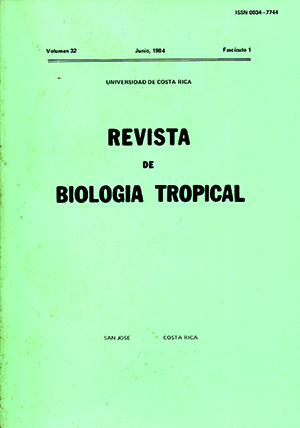Resumen
Sceloporus malachiticus is a diurnal iguanid lizard occupying upland and montane areas through much of Mexico and Central America. In Costa Rica, where field observations were made, this species utilizes various habitats between elevations from about 600 to more than 3,000 meters. In response to the diel march of temperature, activity usually demonstrated a unimodal peak in the late morning hours, prior to the onset of cloud caver. Body temperatures generally exceed those of both ambient air and substratum; active animals exhibit a greater differential than inactive ones. Body temperatures range from 8.4 °C to 34.4 °C, of which the voluntary activity range is 22.0 to 34.4 °C (X28.6 °C). No significant differences were found among different size or sex groupings. Basking behavior is common throughout the range of activity in all groups. Neither hibernation nor acclimation is exhibited in montane S. malachiticus.
In comparing these thermal responses with other sceloporines, the most conspicuous feature of this population of S. malachiticus is its low thermal preferendum. Among the collective voluntary activity ranges and preferenda reported for other members of the genus there is an obvious contrast with the results obtained. Further evidence acquired during this study indicates that thermal preferenda among sceloporines are more characteristic of their autecology than their phylogeny.
Citas
Bogert, C.M. 1949. Thermoregulation and eccritic body temperatures in Mexican lizards of the genus Sceloporus. An. Inst. Biol. Univ. Méx., 20: 415-426.
Brattstrom, B.H. 1965. Body temperatures of reptiles. Amer. Midl. Nat., 73: 376-422.
Buros, T.A. 1970. Temperalures of Yarrows Spiny Lizard Sceloporus jarrovi at high altitudes. Herpetologica, 26: 9-16.
Cloudsley-Thompson, J.L. 1971. The temperature and water relations of reptiles. Merrow, Waterford. 166 p.
Coen, E. 1953. La meteorología de Costa Rica, p. 34-37. In Altas estadístico de Costa Rica. Ministerio de Economía y Hacienda. San José, Costa Rica.
Cole, L.C. 1943. Experiments on toleration of high temperatures in reference to adaptive coloration. Ecology, 24: 94-108.
Cowles, R.B., & C. M. Bogert. 1944. A preliminary study of thermal requirements of desert reptiles. Bull. Amer. Mus. Nat. Hist., 83: 261-296.
Dawson, W.R. 1967. Interspecific variation in physiological responses of lizards to temperature, p. 230-257. In W.W. Milstead (ed.). Lizard ecology: A symposium. Univ. Missouri Press. Columbia, Mo.
Fitch, H.S. 1956. Temperature responses in freeliving amphibians and reptiles of northeastern Kansas. Univ. Kans. Publ. Mus. Nat. Hist., 8: 417-476.
Mayhew, W.W. 1963. Temperature preferences of Sceloporus orcutti. Herpetologica, 18: 217-233. Mueller, C.F. 1969. Temperature and energy characteristics of the sagebrush lizard (Sceloporus graciosus) in Yellowstone National Park. Copeia, 1969: 153-160.
Norris, K.S. 1967. Color adaptation in desert reptiles and its thermal relationsrups, p. 162-229. In W.W. Milstead, (ed.). Lizard ecology: A symposium. Univ. of Missouri Press, Columbia, Mo.
Peten, J.A., & R. Donoso-Barros. 1970. Catalogue of the neotropical squamata: Part II: Lizards and amphisbaenians. U.S. NatI. Mus. Bull., 297. 293 p.
Taylor, E.H. 1956. A review of the lizards of Costa Rica. Univ. Kansas Sci. Bull., 38 (Part 1): 1-322.
Templeton, J.R. 1970. Reptiles, p. 167·221. In. G. C. Whittow (ed.) Comparative Physiology of Thermoregulation. Vol. 1. Acadmic. Press, N.Y.
Vial, J. L 1968. The ecology of the tropical salamander, Bolitoglossa subpalmata, in Costa Rica. Rev. Biol. Trop., 15: 13-115.
Vial, J.L. 1975. Thermal related activity in the Mesoamerican lizard Gerrhonotus monticolus. Brit. J. Herp., 5: 491-495.
Vitt, L J. 1974. Body temperatures of high latitude reptiles. Copeia, 1974: 255-256.
##plugins.facebook.comentarios##

Esta obra está bajo una licencia internacional Creative Commons Atribución 4.0.
Derechos de autor 1984 Revista de Biología Tropical


